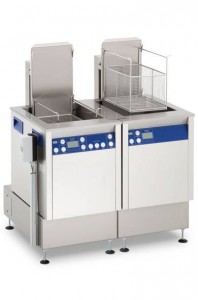Tips on Ultrasonic Rinsing Systems

The Elmasonic Flex Line ultrasonic cleaner with companion rinse tank
Here at Tovatech we get many questions on selecting correct ultrasonic cleaners and ultrasonic cleaning solutions. Sometimes overlooked by customers and prospects is the importance of rinsing the products after they emerge from the ultrasonic cleaning bath. In fact, in many instances, especially with precision or delicate products, ultrasonic rinsing is just as important as the cleaning operation itself.
Why Consider Ultrasonic Rinsing?
Well, maybe you don’t have to. Certain parts such as carburetors or oil pumps may not be affected by the small amounts of cleaning solution residue that remains when they are removed from biodegradable water-based ultrasonic cleaner baths.
At the other extreme surgical instruments, PCBs and similar high-precision products must be thoroughly rinsed for sanitary and performance reasons. In a sentence, the standards that apply to the cleanliness of the product will guide the selection of your rinsing procedures.
Fortunately a variety of rinsing options are available. We describe them here in brief and will be glad to discuss them in detail at your convenience.
Option 1: The Basic
Hold the products under hot running water or swirl them, if practical, in a water tank.
Option 2: A Bit Better
A better and relatively low cost solution to rinsing products is the versatile sprayer-equipped rinsing platform mounted to the side of the ultrasonic cleaning tank.
Since the platform discharges rinse water to a waste line it can also be used to pre-rinse products before they are immersed in the ultrasonic bath. This step will help extend the efficacy of the ultrasonic cleaning solution, which degrades as contaminant content increases.
Option 3: Even Better Yet
The next step up is immersing the products in ultrasonic rinse tank after they have been spray rinsed. This ensures that cleaning solution residues are removed from tiny cracks, crevices and blind holes. A final spray can be with DI or RO water to avoid mineral deposits from hard water. More on this below.
Another Look at Ultrasonic Rinsing
In instances where an ultrasonic rinsing system is recommended consider the following points:
- Cleaning must be carried out completely in the ultrasonic tank under precisely defined parameters for parts being cleaned and the contamination being removed.
- At the end of the cleaning step residues of cleaning media must be rinsed from the cleaned parts. A spray platform with tap water will do this provided it does not leave residues from dissolved minerals. In such a case softened, RO or deionized water should be used.
- High cleanliness standards could require several rinsing steps involving a number of rinsing units including an ultrasonic rinse tank. The number of tanks depends on parameters as cycle-time, rinsing time, amount of fresh rinsing water per batch and water drag out.
- If you establish a 4-tank clean, pre-rinse, rinse and final rinse setup use a cascade system between the rinse and final rinse tanks.
- If corrosion is a concern use an anti-corrosive additive such as elma KS diluted to 0.1% in the final rinse. Hot water will promote flash drying or a hot air dryer can be added to the lineup.
In summary there are several options to enhanced ultrasonic cleaning incorporating rinsing procedures consistent with the degree of cleanliness required. Systems may be manual or automated. Obviously the more complex the system the higher it will cost. Ultrasonic cleaning and rinsing system costs must be weighed against the value of the products being cleaned and the savings automated operations will generate vs. the cost of manual operations.
Contact the scientists at Tovatech for expert advice on setting up and operating an ultrasonic cleaning and rinsing system tailored to your cleaning requirements.
How does your shop handle parts rinsing after ultrasonic cleaning? What challenges did you face and how were they solved?